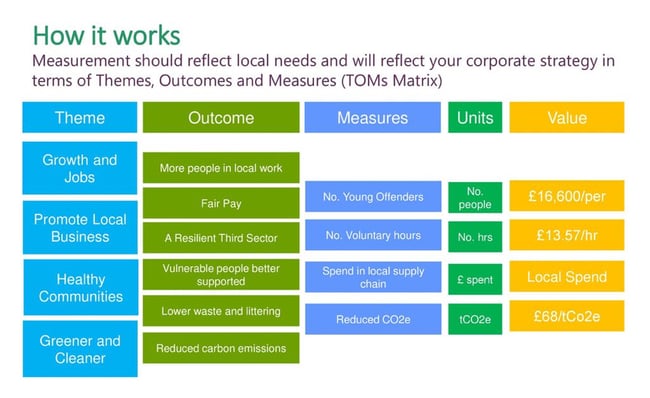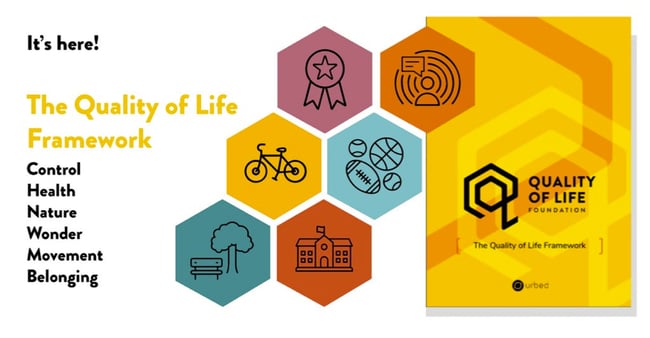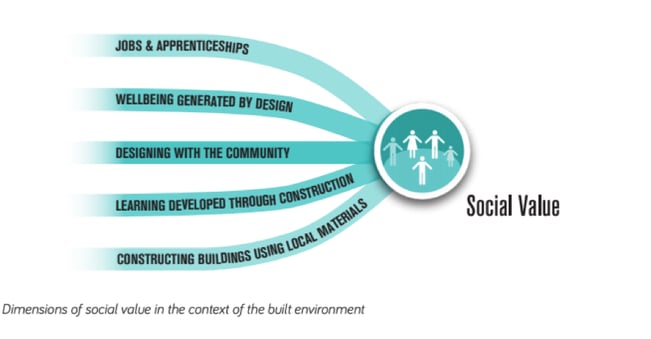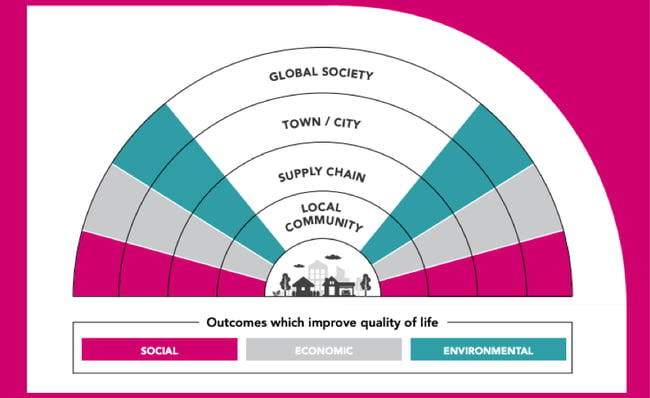How to measure social value through community engagement

By Mike Saunders | 31/03/21 10:25
4 min read
Social value is defined in myriad ways, depending on the context, the desired outcome and who is providing the definition. Therein lies one of the biggest challenges of measuring and using it: there is not one standard, one definition or even one understanding of what it means.
With or without a solid definition, we know that the views, needs and aspirations of the community are an essential part of any holistic view. Our recent Engaging for the Future research and report shows that communities want to be involved in local decisions and insight. There is a huge opportunity for using digital tools to inform our understanding through engagement, and to create a longitudinal analysis that links place, design, planning, construction, post-occupancy, all the way back to place again.
Constructing Value
The use and application of social value is in rapid expansion - and for very good reason: it has the potential to measure the impact of a development on a place and its community.
Whether you’re using TOMs, the Quality of Life Framework, the Social Value Toolkit or the UK Green Building Council’s guidelines, the impact is ultimately all about people. It is crucial that the perspectives of those affected by new developments are taken into account.
Referring back to Maslow’s hierarchy of needs, psychological needs are as important as physical needs, and so is the case in social value: subjective as well as objective outcomes must be understood and measured. Any measurement system is only as useful as the extent to which it captures improvement to the lives of a community.
Three principles to ensure a people-centred approach
The recent Institute of Economic Development (IED) report, From the Ground Up recommended that community engagement form a central component of measuring social value in all construction projects.
Despite the logic of communities being at the heart of social value, the methodology of collecting and measuring community data that informs social value is sometimes overlooked - often because the process is difficult and can be costly. This need not be the case: digital community engagement can yield highly valuable and cost-effective data.
Embedding engagement as part of social value has triple benefits: 1) An input: better understanding of what social means to a community; 2) An important element of social value measurement; 3) An output: better engagement with communities is part of delivering better quality of life through influence, control and empowerment.
The three following principles will help you to better understand community needs in your social value work:
- Adopt a social value framework that puts community engagement at its heart.
There are many social value frameworks and methodologies to choose from (see below). Some of them prioritise community feedback to a larger extent than others. In particular, the Quality of Life Framework is based almost entirely on subjective categories. It is worth understanding how the framework you choose will incorporate community engagement and feedback, for which examples are very useful. - Benchmark questions to track what is important to the community.
Different communities have different priorities. At the very earliest stage of a project, community engagement can be used to establish these priorities. Once understood, a series of questions that measure progress against these priorities can be designed. For example, if a sense of belonging is rated highly, then a question relating to people’s perception of community cohesion might be asked. In some cases, these questions can be benchmarked against the annual Quality of Life Survey, which provides annual data, mapped down to a local level. - Embed consistent social value feedback into every stage of every project.
The benchmarked questions can then be included at every stage of a project’s lifecycle: during pre-planning design or co-design, at planning submission, during construction, and after occupation. By using a digital platform such as Commonplace, the data can be collected and analysed throughout the project lifecycle, providing evidence of the social value delivered by a project over a period of time.
Established tools and approaches for measuring social value
There's no such thing as a perfect measurement for social value, but some frameworks will be better than others at helping you solve your organisation's goals. Here are some of the different methodologies that we have encountered in projects with our clients and partners:
1. Social Value Portal (TOMs)
This is a fantastic tool to track factors that typically deliver social value, based on the TOM (Themes, Outputs and Measures) framework. It is widely used, especially in the development sector, and delivers a £ value for social value.

(Source: Social Value Portal)
2. Quality of Life Framework
The Quality of Life Foundation has produced a framework that identifies six key areas of social value that are required for a high quality of life, Control, Nature, Health, Wonder, Movement and Belonging. Within each of these categories, the framework identifies several principles that contribute (for example, influence is a key principle of Control).

(Source: Quality of Life Foundation)
3. Social Value Toolkit
This toolkit is designed primarily for architects. It was developed by Flora Samual at Reading University and Eli Hatleskog. The toolkit makes heavy use of mapping social value, something that the Commonplace Community Heatmap can help deliver.

(Source: Social Value Toolkit)
4. Social Value International - 7 Principles
The principles laid out in this methodology describe an approach to understanding and then measuring social value, which puts communities at its heart. It is recognised internationally and used by several companies in the UK include in Real Worth.
5. UK Green Building Council
The UKBGC provides a Framework for Defining Social Value that was developed by 23 industry stakeholders in 2020, including Argent and Avison Young. It can be used to define social value for any project or space and takes account of social, environmental and economic contributors to social value.

(Source: UKGBC)
Summary
Community engagement is essential to understanding and defining social value because each community has a different view of what value means to them.
Embedding engagement as part of social value has triple benefits: 1) An input: better understanding of what social means to a community; 2) An element of social value measurement; 3) An output: better engagement with communities is part of delivering better quality of life through influence, control and empowerment.
As the leading community engagement platform for places, Commonplace is an ideal component of any project that seeks to understand, measure and demonstrate social value.
See how Commonplace can help you measure Social Value in your projects
.png)
